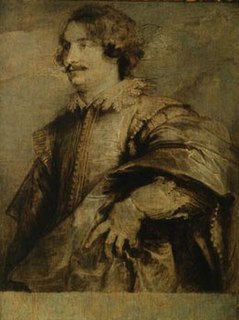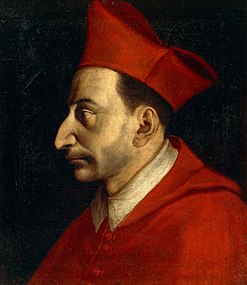
Cornelis de Vos was a Flemish painter, draughtsman and art dealer. He was one of the leading portrait painters in Antwerp and is best known for his sensitive portraits, in particular of children and families. He was also successful in other genres including history, religious and genre painting. He was a regular collaborator with Rubens.

Lucas Vorsterman (1595–1675) was a Baroque engraver. He worked with the artists Peter Paul Rubens and Anthony van Dyck, as well as for patrons such as Thomas Howard, 21st Earl of Arundel and Charles I of England.

Charles Audran (1594–1674) was a French engraver
Jean Audran (1667-1756) was a French engraver and printmaker. The brother of Benoit, and the third son of Germain Audran, he was born at Lyons in 1667. After learning the rudiments of the art under his father, he was placed under the care of his uncle, the famous Gérard Audran, in Paris. Before he was twenty years of age he displayed uncommon ability, and became a very celebrated engraver. In 1706 he was made engraver to the king, with a pension and apartments at the Gobelins. The hand of a great master is discernible in all his plates; and without having attained the extraordinary perfection of Gérard Audran, his claim to excellence is very considerable. He died in 1756. His principal prints are:

Jean-Baptiste Barbé (1578–1649) was a Flemish engraver, publisher and art dealer active in Antwerp. He is known for his engravings after his own designs as well as for his reproductive engravings.
Bernard Baron was a French engraver and etcher who spent much of his life in England.

Étienne Baudet, an eminent French engraver, was born at Vineuil, in the department of Loir-et-Cher, about 1636. He was a pupil of Sébastien Bourdon and Cornelis Bloemaert, and afterwards went to Rome, and appears to have adopted the manner of Cornelis Bloemaert in his earliest plates, which are executed entirely with the graver. He afterwards on his return to Paris altered his manner, and calling in the assistance of the point, he executed his best prints, which bear a strong resemblance to the manner of Jean Baptiste Poilly. He made an excellent choice in the subjects of his plates, which are from the works of some of the most distinguished masters of Italy and France. He was a member of the Royal Academy of Paris, in which city he died in 1711.

Abraham Blooteling (1634–1690) was a Dutch designer and engraver.

Schelte a Bolswert (1586–1659) was a leading Dutch engraver, noted for his works after Rubens and Van Dyck.
Cornelis van Caukercken was a Flemish engraver and printseller.

Jean Daullé was a French engraver.

Pieter de Bailliu was a Flemish engraver.
Arnold de Jode, the son of Pieter de Jode, the younger, was born at Antwerp in 1638. He was instructed in engraving by his father, but he never rose above mediocrity. He worked in the Netherlands and in Spain, and was in England in 1666, the year of the great fire in London, and in 1667. His best prints are portraits, though they are but indifferent. Among other plates, the following are by him:

Paulus Pontius was a Flemish engraver and painter. He was one of the leading engravers connected with the workshop of Peter Paul Rubens and worked after Rubens' death for other leading Antwerp painters such as Anthony van Dyck, Jacob Jordaens and others.

Hans Witdoeck or Jan Witdoeck was a Flemish engraver, draughtsman and art dealer. He belonged to the last generation of reproductive engravers who worked for Rubens' workshop from the mid 1630s.
Marinus Robyn van der Goes was a Flemish engraver.

Alexander Voet the Elder or Alexander Voet I was a Flemish engraver, print artist and publisher. He was one of the leading engravers and publishers in Antwerp in the middle and second half of the 17th century. He operated a large workshop in which sixty to seventy collaborators took care of the entire process of printmaking, printing and publishing.

Mattheus Borrekens or Mattheus Borkens was a Flemish engraver, printmaker and draughtsman. He was a reproductive artist and worked on some important publications in the Southern Netherlands. He mainly treated Christian religious subjects and portraits.
The public domain consists of all the creative works to which no exclusive intellectual property rights apply. Those rights may have expired, been forfeited, expressly waived, or may be inapplicable.

Michael Bryan was an English art historian, art dealer and connoisseur. He was involved in the purchase and resale of the great French Orleans Collection of art, selling it on to a British syndicate, and owned a fashionable art gallery in Savile Row, London. His book, Biographical and Critical Dictionary of Painters and Engravers, first published in 1813-16, was a standard reference work throughout the 19th century, and was last republished in 1920; however it is now badly outdated.



























